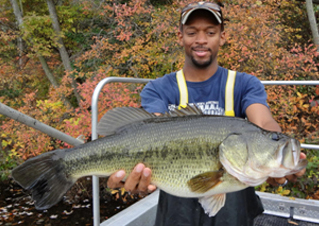10201 Bee Oak Rd.
The Southern Region of the Freshwater Fisheries Program is responsible for managing freshwater fisheries in Anne Arundel, Calvert, Charles, Prince George’s, and St. Mary’s counties. These include those in public lakes and ponds, and the tidal, freshwater portions of the Patuxent and Potomac rivers. Additionally, Rocky Gorge and Triadelphia reservoirs, two properties owned by the Washington Suburban Sanitation Commission, are managed by Southern Region. To manage these fisheries, region biologists conduct surveys to assess fish populations, determine if and when fish stocking should be performed, and improve fish habitat when needed, among other duties.

The
recreational fishing opportunities in southern Maryland are among the best the
state has to offer. Anglers can target warmwater species such as
largemouth bass
and other sunfishes
in tidal rives and impoundments, coolwater species like
Northern pike and
walleye in the large reservoirs. The
Potomac River offers a particularly good opportunity for largemouth bass
fishing, and it’s considered one of the top destinations in the country for the
species.
Southern Maryland also offers anglers the unique
opportunity to target
Northern
snakehead and
blue
catfish, two invasive fish species that are abundant and make
great table fare. They are also fun to catch and the current state records for
both species were caught in the Potomac River. Anglers are encouraged to
harvest both species. As an added bonus, several of the region’s lakes are
stocked with rainbow and brown trout each year as part of Maryland’s
put-and-take
trout fishery.
Recent and Upcoming Projects
Habitat ImprovementDuring the winter of 2020, a number of concrete reef balls were added to St. Mary’s Lake to provide much-needed habitat for fishes. As the impoundment has aged, flooded timber that once served as essential habitat has degraded. The reef balls, constructed by the Maryland Park Service Maryland Conservation Corps (MCC) using molds provided by the Chesapeake Bay Foundation, were placed into two areas of St. Mary’s Lake that were devoid of structure. Most structures were also stuffed with brush to provide additional habitat complexity, which many fish prefer.
Patuxent River Blue Catfish
 Blue catfish are considered an invasive species throughout the Chesapeake Bay and its tributaries. The species is native to Midwestern locales, and the opportunistic feeder can grow to over 100 lbs. It has quickly spread throughout the region and their effects on native fisheries and aquatic ecosystems are unknown.
Blue catfish are considered an invasive species throughout the Chesapeake Bay and its tributaries. The species is native to Midwestern locales, and the opportunistic feeder can grow to over 100 lbs. It has quickly spread throughout the region and their effects on native fisheries and aquatic ecosystems are unknown.
To address these concerns, the department and agency partners (United States Geological Survey and the Atlantic States Marine Fisheries Commissions) are researching diet and movement habits of the species in the Patuxent River. The fish has only recently been found in the river, and it offers an opportunity to learn how best to manage and control the species, as it spreads throughout the state.
During the winter of 2019-2020, biologists examined the stomachs of nearly 500 blue catfish from the tidal Patuxent River. Fish ranged from 12.5 to 41 inches in length and were up to 40 pounds in weight. Mud crabs were the most abundant prey item found, but fish accounted for the most biomass in blue catfish stomachs. Other items of interest found included American eels, blue crabs, and white perch. Diet work will continue through the fall of 2020 to examine seasonal and spatial differences in the diets of the fish.
Read the Results from the Blue Catfish Study